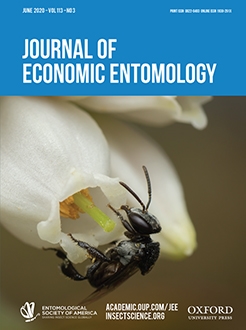Improvements in the mass rearing of Diachasmimorpha longicaudata (Ashmead) on larvae of the Vienna-8 temperature-sensitive lethal genetic sexing strain of Ceratitis capitata (Wiedemann) (Diptera: Tephritidae) (= GSS Vienna-8) at the San Juan biofactory, Argentina, are currently under way. Lowering cost production is a key factor regarding parasitoid rearing. Thus, the variation in mass-reared parasitoid encapsulation levels and the incidence of superparasitism were determined; also, the gamma radiation dose-effect relation on host larvae and the influence of Mediterranean fruit fly strain were considered. Naked Mediterranean fruit fly larvae of both GSS Vienna-8 and a wild bisexual strain (= WBS) aged 6-d-old were irradiated at 0, 20, 40, 60, 80, 100, and 120 Gy, and exposed to parasitoid females. Melanization level was tested for encapsulated parasitoid larval first-instars (= L1). Non-irradiated and irradiated WBS larvae at 20–40 Gy displayed a significantly higher incidence of encapsulation when compared with GSS Vienna-8 larvae. The low melanized level in encapsulated parasitoid L1 was the most common melanization process at 72 h puparium dissection. A high melanized level was only found in non-irradiated WBS larvae. Irradiated GSS Vienna-8 larvae can neutralize the host immunological reactions over irradiated WBS larvae much more quickly. Superparasitism intensity in both Mediterranean fruit fly strains was not affected by radiation doses. High levels of superparasitism seemingly helped to overcome the host's immune reaction by the surviving parasitoid larva. Parasitoid emergence increased from 60 Gy onwards in both Mediterranean fruit fly strains. Radiation in GSS Vienna-8 larvae may favor host's antagonistic reactions decrease in relation with D. longicaudata development.
How to translate text using browser tools
20 April 2020
Radiation on Medfly Larvae of tslVienna-8 Genetic Sexing Strain Displays Reduced Parasitoid Encapsulation in Mass-Reared Diachasmimorpha longicaudata (Hymenoptera: Braconidae)
Lorena Suárez,
María Josefina Buonocore Biancheri,
Guillermo Sánchez,
Jorge Cancino,
Fernando Murúa,
Mariana Bilbao,
Diego Molina,
Osvaldo Laria,
Sergio M. Ovruski
ACCESS THE FULL ARTICLE
It is not available for individual sale.
This article is only available to subscribers.
It is not available for individual sale.
It is not available for individual sale.

Journal of Economic Entomology
Vol. 113 • No. 3
June 2020
Vol. 113 • No. 3
June 2020
Mediterranean fruit fly
parasitoid encapsulation
parasitoid mass rearing
radiation
superparasitism




